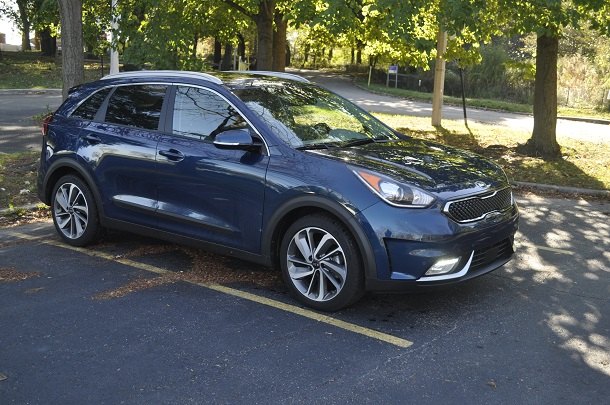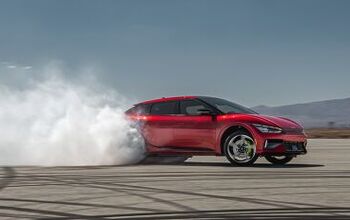2017 Kia Niro Touring Review - Who Says Boring Is Bad?

2017 Kia Niro Touring
Outside of perhaps its front styling – especially the slightly bug-eyed headlamps and the pinched grille – the Kia Niro doesn’t really stand out in a crowd.
It’s quiet, thanks to a hybrid powertrain. It’s compact in length and height. It has a driving experience that isn’t memorable in ways good or bad.
And none of that preceding paragraph is meant as an insult.
Sometimes calling a car “boring” is a bit like saying the wrong thing about a barfly’s mother – an invitation to trouble (metaphorical trouble, in this instance, but trouble nonetheless). Not in this case, though. As much as almost everyone who writes about cars wishes everything we drove was sporty and sleek-looking, that’s not what most buyers want or need. Why else has Toyota sold Camrys and Corollas by the literal boatload, regardless of any criticism from the automotive media?
Yeah, I know, this point has been made before – I’ve certainly written a variation of that previous paragraph multiple times. Self-plagiarism aside, it’s worth repeating because it’s an obvious premise that nevertheless often gets overlooked.
Sometimes a car just works. It does lots of things well, and it doesn’t matter if it’s entertaining or fun or turns heads. That, in a nutshell, is the Niro.
All trim levels have the same powertrain: A 1.6-liter four-cylinder gas engine that mates to an electric motor for a total system horsepower of 139, with a combined torque figure of 195 lb-ft. That power gets to the wheels via a six-speed automatic transmission. Straightforward enough.
Even with almost 200 lb-ft of torque, the Niro feels a bit underpowered, and a 3,000-pound-ish curb weight (it varies by trim) doesn’t help. Plan your passing accordingly.
Kia has been accused in the past of offering poor steering feel, but the company has shown improvement, and that’s the case here. While there are crossovers out there with better, more dynamic steering, the Niro’s unit is at least engaging enough. There’s no numbness or excessive lightness.
Ride is pleasant, and handling is just sporty enough (it’s not all boredom round these here parts). Again, a more engaging personality would be nice, but the Niro doesn’t seem to need it.
That’s in part because, personality aside, my test Niro came in Touring trim — the model’s top trim level. As such, it arrived with features like heated front seats, heated steering wheel, nav, Bluetooth, UVO infotainment, satellite radio, leather seats – the usual when one asks for “the works.” An option package added forward-collision warning, smart cruise control, autonomous emergency braking, and lane-departure warning.
The “it just works” theme carries over to the inside. The radio has volume and tuner knobs in just the right place, the climate controls are simple and straightforward (as well as easily reached), and the touchscreen is intuitive and switches menus quickly. Graphically, it’s easy to read.
The USB port is in a convenient place, just fore of a small storage area and the cupholders. Nothing is fancy here, but everything is in the place where you’d expect it to be.
Rear-seat room is a tad tight, but legroom is class-competitive and headroom is only bested by the Ford C-Max. My tall frame was completely comfortable up front.
A nagging question bugged me during my entire time in the car – is the Niro a crossover or a wagon? The TTAC editorial staff was split. It doesn’t necessarily look like a wagon – the cargo area is too truncated. But in some ways, it feels like one. That’s also not an insult, by the way.
Yeah, Kia will market it as a CUV, and as noted, the editorial braintrust is split on whether it’s a wagon or not. To me, it has the same qualities that make small wagons appealing to so many.
Whatever it is, it has a lot going for it. Aside from a lack of punch and so-so steering, it’s not disappointing to drive. It’s not a looker, per se, but it’s not ugly – and to be fair, my tester came painted in a slightly pedestrian shade of blue. I’ve seen Niros with the red paint job that have more flair (sorry, Mike Judge).
I know, I know, a well-packaged car isn’t the most exciting thing in the world. But that’s the point. There’s a lot to like about the Niro, including fuel-economy ratings of 46 mpg city/40 mpg highway. It’s a package that just works.
That said, the sticker price for the Touring trim I tested reached $32,575, and that takes some of the shine off.
If you don’t need all the bells and whistles, you can get a LX or EX trim for a bit less money. That would give you nice value for a fuel-efficient daily driver that does lots of things well.
Not sexy, sure. But it doesn’t matter – you’ll be spending your energy figuring out if you own a wagon or a crossover, and that’s a debate that’s sure to never bore you.
[Images: © 2017 Tim Healey/The Truth About Cars]

Tim Healey grew up around the auto-parts business and has always had a love for cars — his parents joke his first word was “‘Vette”. Despite this, he wanted to pursue a career in sports writing but he ended up falling semi-accidentally into the automotive-journalism industry, first at Consumer Guide Automotive and later at Web2Carz.com. He also worked as an industry analyst at Mintel Group and freelanced for About.com, CarFax, Vehix.com, High Gear Media, Torque News, FutureCar.com, Cars.com, among others, and of course Vertical Scope sites such as AutoGuide.com, Off-Road.com, and HybridCars.com. He’s an urbanite and as such, doesn’t need a daily driver, but if he had one, it would be compact, sporty, and have a manual transmission.
More by Tim Healey
Latest Car Reviews
Read moreLatest Product Reviews
Read moreRecent Comments
- Bd2 Lexus is just a higher trim package Toyota. ^^
- Tassos ONLY consider CIvics or Corollas, in their segment. NO DAMNED Hyundais, Kias, Nissans or esp Mitsus. Not even a Pretend-BMW Mazda. They may look cute but they SUCK.I always recommend Corollas to friends of mine who are not auto enthusiasts, even tho I never owed one, and owned a Civic Hatch 5 speed 1992 for 25 years. MANY follow my advice and are VERY happy. ALmost all are women.friends who believe they are auto enthusiasts would not listen to me anyway, and would never buy a Toyota. They are damned fools, on both counts.
- Tassos since Oct 2016 I drive a 2007 E320 Bluetec and since April 2017 also a 2008 E320 Bluetec.Now I am in my summer palace deep in the Eurozone until end October and drive the 2008.Changing the considerable oils (10 quarts synthetic) twice cost me 80 and 70 euros. Same changes in the US on the 2007 cost me $219 at the dealers and $120 at Firestone.Changing the air filter cost 30 Euros, with labor, and there are two such filters (engine and cabin), and changing the fuel filter only 50 euros, while in the US they asked for... $400. You can safely bet I declined and told them what to do with their gold-plated filter. And when I changed it in Europe, I looked at the old one and it was clean as a whistle.A set of Continentals tires, installed etc, 300 EurosI can't remember anything else for the 2008. For the 2007, a brand new set of manual rec'd tires at Discount Tire with free rotations for life used up the $500 allowance the dealer gave me when I bought it (tires only had 5000 miles left on them then)So, as you can see, I spent less than even if I owned a Lexus instead, and probably less than all these poor devils here that brag about their alleged low cost Datsun-Mitsus and Hyundai-Kias.And that's THETRUTHABOUTCARS. My Cars,
- NJRide These are the Q1 Luxury division salesAudi 44,226Acura 30,373BMW 84,475Genesis 14,777Mercedes 66,000Lexus 78,471Infiniti 13,904Volvo 30,000*Tesla (maybe not luxury but relevant): 125,000?Lincoln 24,894Cadillac 35,451So Cadillac is now stuck as a second-tier player with names like Volvo. Even German 3rd wheel Audi is outselling them. Where to gain sales?Surprisingly a decline of Tesla could boost Cadillac EVs. Tesla sort of is now in the old Buick-Mercury upper middle of the market. If lets say the market stays the same, but another 15-20% leave Tesla I could see some going for a Caddy EV or hybrid, but is the division ready to meet them?In terms of the mainstream luxury brands, Lexus is probably a better benchmark than BMW. Lexus is basically doing a modern interpretation of what Cadillac/upscale Olds/Buick used to completely dominate. But Lexus' only downfall is the lack of emotion, something Cadillac at least used to be good at. The Escalade still has far more styling and brand ID than most of Lexus. So match Lexus' quality but out-do them on comfort and styling. Yes a lot of Lexus buyers may be Toyota or import loyal but there are a lot who are former GM buyers who would "come home" for a better product.In fact, that by and large is the Big 3's problem. In the 80s and 90s they would try to win back "import intenders" and this at least slowed the market share erosion. I feel like around 2000 they gave this up and resorted to a ton of gimmicks before the bankruptcies. So they have dropped from 66% to 37% of the market in a quarter century. Sure they have scaled down their presence and for the last 14 years preserved profit. But in the largest, most prosperous market in the world they are not leading. I mean who would think the Koreans could take almost 10% of the market? But they did because they built and structured products people wanted. (I also think the excess reliance on overseas assembly by the Big 3 hurts them vs more import brands building in US). But the domestics should really be at 60% of their home market and the fact that they are not speaks volumes. Cadillac should not be losing 2-1 to Lexus and BMW.
- Tassos Not my favorite Eldorados. Too much cowbell (fins), the gauges look poor for such an expensive car, the interior has too many shiny bits but does not scream "flagship luxury", and the white on red leather or whatever is rather loud for this car, while it might work in a Corvette. But do not despair, a couple more years and the exterior designs (at least) will sober up, the cowbells will be more discreet and the long, low and wide 60s designs are not far away. If only the interiors would be fit for the price point, and especially a few acres of real wood that also looked real.








































Comments
Join the conversation
Nobody knows if this is a wagon, CUV, or hatchback, so nobody will buy it. If they are marketing it as a CUV, it should at least have an AWD option. Sheeple don't buy ambiguous products. As good as their products are, Kia still cannot sell on their name, alone. The Niro marketing will have to create a strong identity that makes sheeple feel warm and fuzzy (no, not more hamsters), or it will end up just like the Mazda 5 and Ford C-Max. And then there is the price. Sure, it's a hybrid and it probably drives better than any Prius, but it's still $30K for a Kia.
FWIW, Motorweek has one of these as a long term tester. First update 11/03 17. I'm still waiting for the PHEV, can't find much on it.